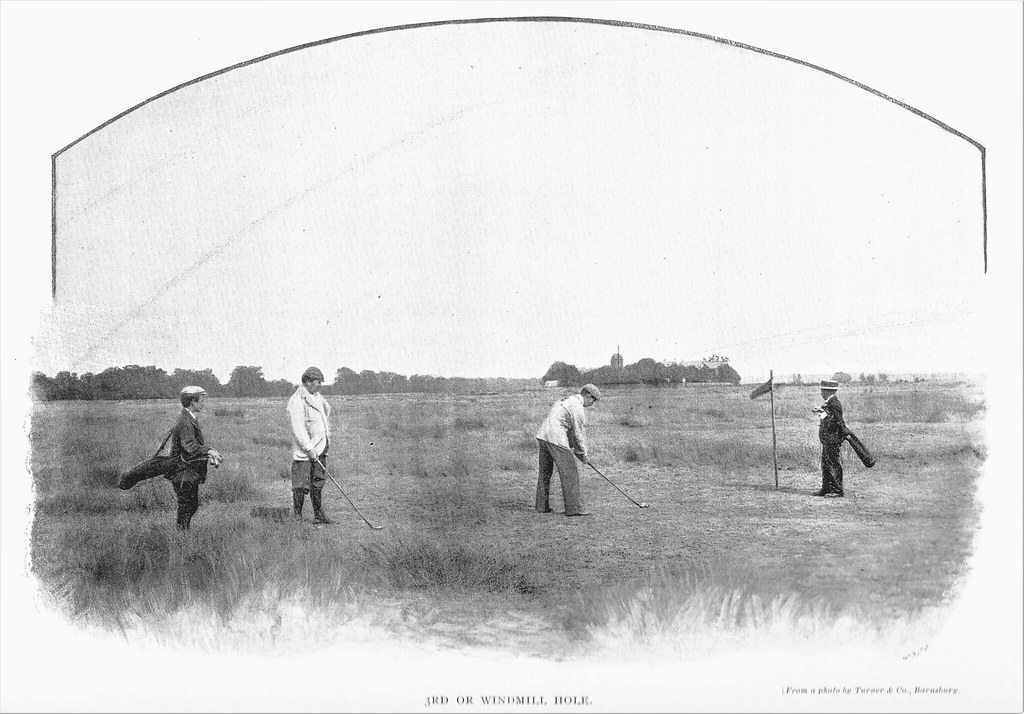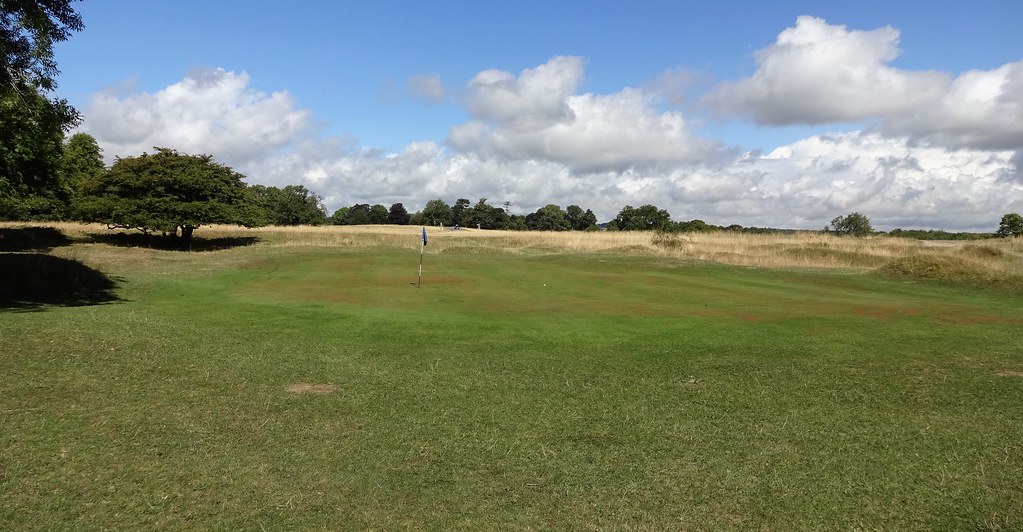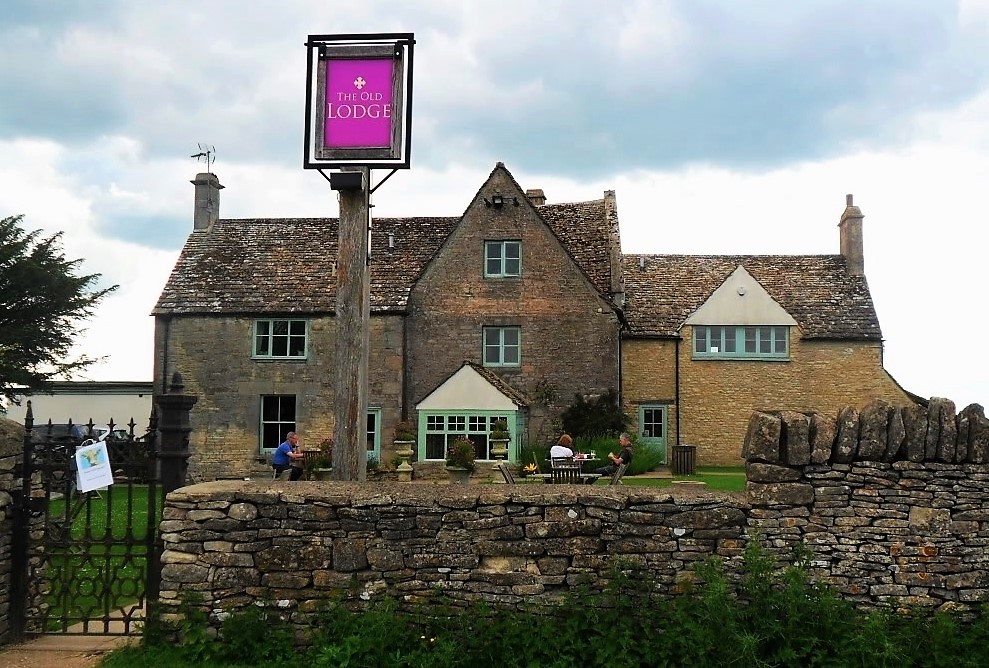
A warm greeting at the house door.

A typical Minch Old scene. The 18th as seen from the 1st fairway.

Minchinhampton Old is an open grassland course 700 feet above sea level on a spur of the Cotswolds. Stroud is some three miles distant, Nailsworth Valley is to the west and Frome Valley the north. Opened in 1889, the course is situated on the magnificent Minchinhampton Common. RB Wilson of St Andrews is credited with the original design, though there have been many alterations over the years. Mr Robert Black "Buff" Wilson apprenticed under Old Tom Morris as a club maker and continued this profession throughout his career. Among several seemingly short lived postings, Mr Wilson served as the pro at Shinnecock Hills for a period in 1896-97.
There may be only a few original greens (5, 8 & 11 are the likely candidates) and likely no more than a few complete holes in play. That said, I believe the 11th is only original hole remaining from the 1889 design. I should mention there are two newer courses, one built in the 70s and one in the 90s. The Old Course is part of the same club, but about three miles away.
The bunker free Old Course has very little fairway shaping and is punctuated with iron age fortifications, quarries, Kingtonesque earthworks around some of the greens and the ever present wind. Despite the lack of fairway shaping, there is no question the designers knew what they were doing as the angles presented bear the hallmarks of strategic golf. It should be noted that Horace Hutchinson thought enough of Minch Old to include it in his British Golf Links, a highly recommended book.
Despite the clever subtleties of the design, my favourite aspect of Minchinhampton is it's true common nature. Minch Old generally circles in a wide clockwise arc around the 580 acre common and through the remains of an iron age fort. There is a long tradition of golf on common land in England, but Minchinhampton feels unique to me. The course crosses several roads while sharing the land with walkers, horse riders, children at play, cows and horses. Minch Old was the first time I have had the pleasure to experience a true common golf scene as one might have found 125 years ago.
There are open views in every direction, but many of the holes have a strangely semi-blind nature from the tee. Usually this is due to a slight rise in the fairway, but there is also a lack of elements such as shaping, bunkers or trees to act as a guide or help with estimating distance. Below is a view of the Windmill Hole not long after the course opened.

Modern Routing

1947 Routing

Card of the course.

The opening hole is a short par 5 which turns slightly around a turf wall slashing into the right side of the fairway.

A look at the green with its lovely simplistic shaping.

The narrow green is quite evident in this photo from right of the green.

The second turns back on the opener. Heading back up the hill at a slightly diagonal angle, a turf dyke cuts off the approach from the right. The shaping for this incredibly small and relatively new green (mid 90s?) is obviously modern, however, it works.

The third is another somewhat blind tee shot which requires one to gain the far right side of the fairway or be left facing the very awkward approach pictured below. In reality there is plenty of room.

Nevertheless, going long especially in keen conditions is the likely result of approaching from the wrong side of the fairway, but it is no great hardship.

The simple beauty of Minchinhampton is most apparent on these open grassland holes. It is clear the fairways are much too narrow given the wind, but in conditions such as this with the rough down it doesn't much matter.

I am not sure of the original purpose for this trench, but the designers put it to good use.


#5 features another obscured tee shot heading for a squared off green hanging on the edge of a creek valley. Due to regulations, I believe only six greens can be fenced at the same time and only for repair work.

We now cross a road to play a curious two-shotter. Originally the tee was on the near side of the road necessitating a drive over a quarry. The modern driving line isn't obvious and it may pay to lay up as this par 4 isn't long. That said, once spotting a flag through the trees it may be a strong temptation to have at it. It is easy to get caught up with the aesthetics of the site...and rightfully so.

The 7th is another hole where one hits into an open fairway with only waves of grass to kill the aggressive instinct. Livestock can obscure the view!

The quarry on the left can't be seen until hitting the approach. To top it off the green is raised from that angle and runs away. It isn't great golf, but one must certainly think their away around the course.

Keeping well right off the tee makes life easier. The modern mounding gives this green away as fairly new (mid 90s). The original green was located on the far side of the quarry to left.

Minchinhampton's first par 3 is a hum dinger and may be the best hole on the course. Humps block out the approach from the right so one must hit in the direction of the treeline. These photos are forward of the tee.


There is perhaps 10 yards of open ground between the humps and the green.

We now cross another road and head away from the attractive stone's-throw-away village of Amberley to play the 9th. We finally encounter a hole which is reminiscent of modern golf with all there is to see! However, all is not what it seems. Playing safely right of the quarry (evidenced by trees on the left) leaves a dreadful angle in which one will do well to hit the green let alone flag hunt.


The infectious nature of Minch Old compels some to do cartwheels.

The home nine starts with a deceptively difficult wee hole which was built in the 90s. Practically all changes were due to road safety.


The purple patch continues with Tom Longs. The hole celebrates (it is the club logo) the post which is the road sign behind the green. The use of trees on this hole is one of the best I have encountered when the back tee is in play. Take aim just right of the trees then fire away at Tom Longs Post. Stroud Brewery brews an ale called Tom Long, named after a mythical highwayman hung and buried at the post.


The green is quite surprising as it is located in an old quarry! For some odd reason the orginal green was just in front of the quarry. The 12th is in the background. Consider how many holes could fit into that space and it gives an inkling of Minch Old's scale.


Yes, the golfer must cross another road for the lone par 5 on the back nine; a grassland hole. I find these open spaces extremely pleasant places to play the game. The greensite is rather listless these days. The green used to be located to the right between a dry ditch and the road...again, this may have been changed in the mid 90s. More road crossing for the very odd 13th for which I am gaining a real appreciation over time.

The fairway ends at a ditch (part of iron age fort) running diagonally across the fairway. There is a flag out right, but one cannot see what lies between the tee and the green. As it turns out, if the rough is light and if one doesn't mind taking on the road, the up the gut approach is much easier. The further left one goes the worse the angle and the fairway runs out. Below is a look at the approach from atop the dyke. One can readily see that approaching from this line is problematic.

Looking back to the tee. The old fairway is plagued by the road, but this tee shot is still on!

The next two holes are nothing special. 14 is newish and tough, but a somewhat dull short hole. 15 too is a bit boring, a longish blind two-shotter. Although, there are some great features near the green which were oddly not used. However, the one shot 16th is a lovely looking and an excellent hole. It looks much further than its 150 yards - not quite sure why. In some ways, this is the perfect par 3. There is a strong element of do or die, but should one fail to hit the target, there are recovery shots. Going over the road is easily done given the carry element of the hole. Itís a tragedy that all the quarries aren't as well kept clear of trees etc as is the case for 16 and 17.

Left of the green.

The strongly tilted back to front green is punctuated with contour.

A painting which appeared in a 1890 edition of the London Illustrated News. This may be the original 14th, currently in the area of the 16th & 17th...not much has changed!

A very fine drivable par 4, the 17th fairway slopes in a quartering angle left to right and toward the green. I believe the tee used to be on the far side of the road, creating a much more intriguing angle for the drive.

A drive in the left rough can leave a struggle for par. The expertly placed hollow shy of the green can just be seen.

A look at the green from near the road.

Our last road crossing takes place for the final hole. Once again, I think the tee used to be on the other side of the road making for a far more demanding tee shot. A tee near the 17th green would also make more sense for the earth works near the green. The hole is now otherwise straightforward except for when the grazing cattle and horses become stubborn. The cows are released every year on 13 May; called Marking Day because prior to release the cows are held in a pen near The Old Lodge for marking.


The horses are on hand to say good bye.

While the modern clubhouse is directly behind the 18th, the Old Lodge at one time had a club room for members. Its a shame this still isn't the case as this is a terrific pub. I had a look at one of the six rooms upstairs and it looked to be comfortable. One could do a lot worse than stay on the common when touring around!

Back in the day.

Surprisingly, much of Minch Old isn't terribly old and little of the orginal 1889 design remains as the course underwent drastic alterations from its inception through WWII. In later years many green sites and tees were altered for safety reasons. The general post WWII routing is fairly well in place and regardless of age the course displays remarkably competent and compelling architecture which can be overlooked given the beautiful site. On the other hand, because Minch Old is visually alluring, it may be easy to disregard the short-comings of the course such as several road crossings, road noise, lack of movement in fairways, rather one dimensional shaping and green conditions which can be politely called wanting.
I suspect as the course is on common land maintenance restrictions are fairly rigorous....which is a shame as there are bones of what could potentially be an outstanding course. Even so, if approached in the right spirit, Minch Old is a lot of fun and doesn't require the equivalent purchase of an acre of land to be tempted by its delights. The 16th is an All-England candidate, but there are many wonderful holes such as 1, 7, 8, 9, 11, 13 & 17. Minch Old provides more than enough interest. Like Painswick, it is difficult to award a star because of the maintenance au naturel, but I shall continue to return if only to experience playing proper common land golf. 1* 2025
A special thank you is due to Col Kurtz, the secret agent of Oxford, for recommending I see Minch Old. Cheers CK!
Ciao